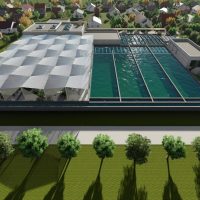The Organica FCR has already proved several times that it can be adapted to almost any situations, but just how flexible is it?
by Peter Varga, Business Development Manager at Organica Water
Opportunities Abound
Working in Business Development, we are typically the first to hear about a new possibility for a localized WWTP powered by Organica. We get requests for information from all corners of the globe – spanning California to Russia to New Zealand – for facilities ranging from a small lettuce processing plant on a farm to a localized wastewater treatment facility on a commercial property.
If you look at our reference list, you will see projects from the French countryside to the Chinese megacities, with a huge diversity of physical settings, design parameters, and market conditions. Ranging from upgrades of existing facilities to meet stricter effluent requirements or reduce odor issues, to greenfield projects in a location that minimized sewer network costs, what is clear is that – while there is no “one size fits all” solution to wastewater treatment – we see increasing demand from end users for economic (lower infra costs, land value preservations, cost-efficient reuse) and sustainability benefits associated with our localized approach to wastewater management.
Business Development has an interesting role requiring it to understand client needs, and translate those into terms that our engineers can use to carry forward a design that fits those needs. Often times, just obtaining the relevant information in a satisfactory way requires constant back-and-forth over many weeks, in spite of all the tools we have built over the years to collect information.
Staying Flexible
It helps to have a variety of options – ranging from our continuous flow Organica Food Chain Reactor (FCR), configured in both pure fixed-film and hybrid modes, as well as our Organica FBR batch process – to offer clients considerable design and operational flexibility. For example, in locations where civil costs and lad value are high and space is limited (most cities of the world), we can completely do away with huge clarifiers and go straight to disc filtration without overly expensive membranes, an offering relatively unique to the fixed-bed pure FCR process.
Sample Organica Food Chain Reactor (FCR) schematic
|
There are considerations for operational costs as well, particularly given the generally lower energy requirements of our process. While we tend to focus on the pure FCR process as it has both lower aeration energy costs and the ability to eliminate clarifiers, we also have the ability to operate the fixed film process as a hybrid, using suspended growth as well in order to boost biomass. This can be very useful when trying to fit into an existing reactor volume (for an upgrade to meet stricter effluent limits, for example), or for situations where minimizing physical footprint is a priority over aeration energy costs. This option can also be applied to those opportunities where biological phosphorus removal is required, or where chemical usage must be minimized.
Similarly, we have designed projects that involve planned future growth in either capacity, or in anticipation of stricter effluent limits (Total Nitrogen limit, for example). Having a modular process with parallel trains can make phasing very efficient with provisions for future operational reactor trains, or nutrient removal being quite straightforward.
Given all of the variability we see in designs, the one thing that is clear is that the world IS changing. Most utilities no longer want huge, odor-producing WWTPs. People are starting think about ways to treat local, in order to preserve land values, lower infrastructure costs, enable optionality for reuse, and reconnect with the community. In addition, it is clear that facility performance (OPEX) and flexibility matter more and more, especially in emerging markets that are trying to limit some of the same mistakes we made in the past in the West.



